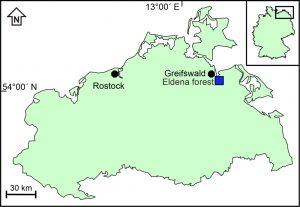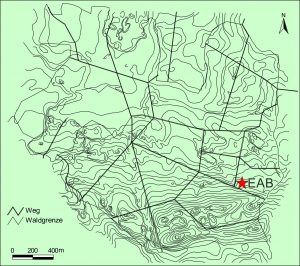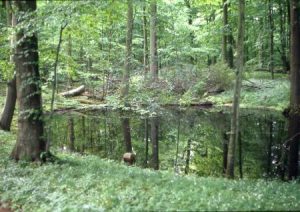Pollen analysis of a small basin in the forest “Eldena” near Greifswald (NE Germany)
The forest Eldena is located east of Greifswald and is property of Greifswald University. For these reasons, the area is ideal for scientific excursions and investigations. In the recent past, it was subject to extensive vegetational, geomorphological and soil-scientific investigations (Helbig 1999; Helbig et al. 2002; Kwasniowski 2001; Spangenberg 2001, 2008; Spangenberg et al. 2003). As pilot study for the PhD-thesis of Almut Mrotzek (previously Spangenberg) a core from “basin 14” (EAB) in the eastern part of the forest was studied on pollen and macrofossils. The basin is very small (maximum diameter ca. 20 m) and, therefore, the data give mainly information on the vegetation directly around the basin. The record from the basin is rather fragmented and, therefore, provides only some extracts from the vegetation history.
 Location of the nature cosnervation area “Eldena” in northeastern Mecklenburg-Vorpommern
Location of the nature cosnervation area “Eldena” in northeastern Mecklenburg-Vorpommern
The earliest registered vegetation phase is the Hippophaё phase (“Bølling” or later part of the “Meiendorf”) (for the terminology of the vegetation phases of Vorpommern see the section on the Endinger Bruch area). Extremely high values of pollen attributable to Hippophaё (over 75%) demonstrate the importance of this shrub directly around the basin. Open vegetation phase II (“Older Dryas”) witnessed a decrease of sea-buckthorn and an expansion of juniper and dwarf birches. The beginning of the Lateglacial Betula/Pinus forest phase (“Allerød”) is registered by an increase of pollen attributable to tree birches. The macrofossils show a succession from an open water phase at the beginning of the Hippophaё phase to a brownmoss dominated vegetation during the later part of this phase and the subsequent vegetation phases.
 Location of basin “EAB” within the forest Eldena
Location of basin “EAB” within the forest Eldena
Almost the complete Lateglacial Betula/Pinus forest phase (“Allerød”) as well as the beginning of Open vegetation phase III (“Younger Dryas”) are not registered: either the basin had been completely dry during these phases, or a later lowering of water levels had destroyed previously formed sediments/sedentates.
Open vegetation phase III and the subsequent Early Holocene Betula/Pinus forest phase (“Preboreal”) are beautifully registered over a depth trajectory of ca. 1.5 m. The complete core section corresponding with these phases consists of brownmoss peat, with the exception of the upper ca. 15 cm that consists of Sphagnum peat. Ample finds of Botryococcus in the core-section covering Open vegetation phase III demonstrate wet conditions during this phase, whereas during the Early Holocene ferns (probably mainly Thelypteris palustris) became dominant in the basin.
 Eldena basin 14 (Photo: Pim de Klerk)
Eldena basin 14 (Photo: Pim de Klerk)
The subsequent vegetation phases are not registered due to another hiatus. Only a fragment of a (not precisely datable) phase of the middle Holocene is present that is characterised by prominent presence of Tilia around the basin. The macrofossils demonstrate presence of an alder carr within the basin.
The top of the pollen diagram shows a prominent open phase with many pollen types indicative for agriculture, followed by a pollen signal that indicates forest regeneration. These phases are correlated with the Roman Iron Age and the Migration Period. Also pedological investigations demonstrate a mainly unforested landscape scenery for the Roman Iron Age with ample soil erosion (Helbig 1999; Helbig et al. 2002; Kwasniowski 2001). Macrofossils indicate that during these phases open water was present within the basin. At present, the basin is filled with water during the winter seasons, but dries out during the summer.
This reseach was carried out in close cooperation with Almut Mrotzek and Dierk Michaelis.
Publication:
De Klerk, P., Michaelis, D. & Spangenberg, A. (2001): Auszüge aus der Weichsel-spätglazialen und holozänen Vegetationsgeschichte des Naturschutzgebiets Eldena (Vorpommern). Greifswalder Geographische Arbeiten 23: 187-208.
Related publications:
Helbig, H. (1999): Die spätglaziale und holozäne Überprägung der Grundmoränenplatten in Vorpommern. Greifswalder Geographische Arbeiten 17: 1-110.
Helbig, H., de Klerk, P., Kühn, P. & Kwasniowski, J. (2002): Colluvial sequences on till plains in Vorpommern (NE Germany). Zeitschrift für Geomorphologie N.F., Supplementbände 128: 81-100.
Kwasniowski, J. (2001): Die Böden im Naturschutzgebiet Eldena (Vorpommern). Greifswalder Geographische Arbeiten 23: 155-185.
Spangenberg, A. (2001): Die Vegetationsentwicklung im Naturschutzgebiet Eldena (Vorpommern) in der zweite Hälfte des 20. Jahrhunderts. Greifswalder Geographische Arbeiten 23: 227-240.
Spangenberg, A., Billwitz, K., Herzberg, I. & Landgraf, L. (2003): Das Naturschutzgebiet Eldena. Greifswalder Geographische Arbeiten 30: 7-23.
Spangenberg, A. (2008): 2000 Jahre Waldentwicklung auf nährstoff- und basenreichen Standorten im mitteleuropäischen Jungpleistozän – Fallstudie Naturschutzgebiet Eldena (Vorpommern, Deutschland). PhD-thesis, Greifswald University.
Your e-mail address will not be published.